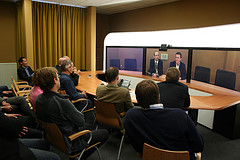What is Telepresence and what are its components?

Picture Courtesy – http://www.flickr.com/people/smartcities/
What is Telepresence?
Telepresence is a combination of a number of high quality audio, HD video, content collaboration tools, lighting, conference tables and chairs, huge multiple display devices etc. which enable the participants to see and talk to remote locations, as if they were in the same room, sharing the same table. An example of telepresence is shown in the picture above.
How Telepresence creates an immersive real-time meeting atmosphere:
Telepresence is about creating the “Same Room” experience to all the participants. That comes from a number of factors.
High quality audio: Telepresence creates a feel as if the person in the remote site is actually talking to you from the same room. Multi-channel audio can provide directional cues as to who is speaking by enabling the sound from a particular speaker in the remote site come from a particular direction (from the location where the monitor displaying them is present, for example). In addition to this, the audio is clear, audible and echo-free.
High quality video: Video is displayed in big display units (like three 65″ LCD monitors which can display life size display of the remote participant as in the above picture) and create a feel of seeing and speaking to them in real time. The size, eye synchronization etc. of the remote participants are ensured to be similar to the experience, if they were in the same room. For this, the three different cameras are placed just over the LCD monitors, each focusing a different part of a room and creating a unified image in a similar set up in the remote location.
Immersive Environment: Telepresence is more than just audio and video: It creates a whole similar environment in multiple sites to create a feel as if they were in the same room. So, the furniture – conference room tables, chairs, wall paint colour, fixtures, lighting etc. are similar in all the locations. Even the table is arranged in such a way that user can see one half of the table in his room, and the other half on the monitor to create an illusion that all of them are in the same room.
Simplicity: Most of the Telepresence systems are perfectly pre-configured (for a particular number of participants from each side) and do not require the participants to touch any of the settings, perhaps other than the “On” button. In fact, many features of the video conferencing systems like zooming, rotating the camera etc. are disallowed in Telepresence so that the immersive real time feel does not get altered. Even the collaboration is enabled through simple touch screen monitors on the table which displays the content that is shared from the other side.
Components of a Telepresence solution:
A Telepresence solution like the one shown in the picture above would be requiring the following components: 3 x 60″/ 65″ Full HD LCD Displays, 3 x HD Video Conferencing/Telepresence Codecs. 3 x HD 1080p Cameras, 3 x Speaker modules, 6 x directional microphones, integrated table, ceiling mounted studio lighting modules, similar chairs and optional three units of LCD touchscreen displays for content presentation. Only the basic components of one type of Telepresence are displayed here, for your understanding. There are certain Telepresence solutions that display much more people in a meeting hall set up with rear projection LCD Screens etc, and there the configuration may be entirely different.
Interoperability between Telepresence and Video Conferencing:
Telepresence, at its heart is the collaboration between multiple HD Video Conferencing systems. So, a Telepresence call can be set up between a Telepresence unit and video conferencing system (multiple of them, in different combinations) and even multi party conferences can be set up. The picture in this article is displaying a session between a video conferencing unit and Telepresence system and hence only the middle display is occupied. If the call was between two or multiple Telepresence systems, all the three displays would have been occupied.
Bandwidth requirements for Telepresence systems:
While HD Video Conferencing systems might require in addition to 1.5 Mbps per site, Telepresence systems may require about 15 to 20 Mbps of bandwidth per site.
So, as you can see from the above description, Telepresence systems are quite expensive but they seek to create an immersive “same room” experience which might be critical for certain applications. Perhaps organizations could first experience the managed Telepresence solutions (where the whole set up is available for rent) before going in for their own set up.
excITingIP.com
You could stay up to date on the various computer networking technologies by subscribing to this blog with your email address in the sidebar box mentioned as “Get email updates when new articles are published”